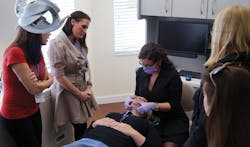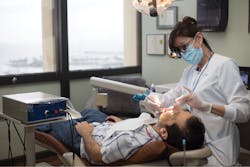The power of teamwork: Spotting signs of instability during hygiene checks
Kimberley Daxon, DDS
In late 2017, Mr. Smith came into my office for his regular six-month checkup and prophy with the hygienist. He reported no issues since his last visit, but the hygienist still performed a complete assessment, including checking for mobility in each tooth.
The Dawson Academy encourages team training to make sure the entire dental team strives for common goals.
As the hygienist probed for mobility, she noticed tooth No. 5 had Class II mobility. She asked the patient if he had any discomfort or if anything had changed since his last visit, and again, he reported no issues.
However, the hygienist decided to have an x-ray examination performed on Mr. Smith. As it turned out, he had a root fracture. The fracture could have been easy to miss because the patient did not have symptoms, but the hygienist was able to spot the hidden problem during a thorough exam.
Of all the members of a dental practice, hygienists have the best opportunity to identify signs of instability because they typically see patients more frequently than dentists for regular prophies and checkups. With the right tools and training, hygienists can best support the dentist’s efforts to provide complete care and keep patients healthy.
Training hygienists to recognize signs
Completing assessments during each prophy, such as the one performed on Mr. Smith, derives part of the hygienist training portion from The Dawson Academy’s foundational approach and practice of complete dentistry. Simply put, complete dentistry is the practice of viewing and understanding the masticatory system (temporomandibular joints, muscles, teeth, and periodontal supporting structures) as a whole and treating the underlying causes of issues.
With the complete dentistry philosophy, dentists and hygienists can more clearly see when the masticatory system is not working properly because signs show up in the teeth and gums during each exam. Hygienists who learn complete dentistry, recognize signs, and understand the “why” behind the signs they’re seeing can help the practice follow the complete dentistry philosophy.
For example, dentists and hygienists know why patients get cavities, so they’re confident when talking to patients about how to treat cavities. Most hygienists see signs of occlusal instability, such as wear, abfraction, cracks, and drifting, but they might not understand all of the underlying issues.
Hygienists can help support dentists in their practices of complete dentistry by encouraging the dentists to perform complete exams and occlusal analyses for all new patients. Instability can be found in each of the four parts of the masticatory system:
- Temporomandibular joints—Signs of TMJ instability include limited range of motion, joint noises, jaw asymmetry (the chin will point to the affected side), midline discrepancies, anterior open bites, and occlusal and bite changes.
- Muscles—Some signs and symptoms of muscle instability are headaches, jaw quivering, jaw fatigue when chewing or during dental treatment, limited or irregular range of motion, and palpation tenderness.
- Occlusal and teeth—Signs of occlusal and teeth instability are wear, mobility, fractured teeth or fillings, shifting of tooth positions, open contacts, abfractions, and tori and posterior interferences.
- Periodontal supporting structures—Signs of periodontal instability include recession, bleeding upon probing, minimal attached gingiva, increased or isolated probing pocket depth, and furcation (bone loss) involvement.
Signs differ from symptoms because they’re clues that a patient has some level of instability or concerns, whereas symptoms are a result of signs going untreated. The key is to find signs before they turn into symptoms and the patient feels pain or discomfort.
Hygienists can also ask leading questions to direct patients to the importance of an issue, such as, “Has anyone ever told you what would happen if your gum recession continues?” Leading questions can help illustrate the implications of not treating the issue.
Implementation of complete care
Implementing this process cannot be accomplished overnight. When a practice implements complete care, including having hygienists look for signs of instability, there are many checklists that practices can follow for each step: (1) medical history, (2) complete exam assessment, (3) periodontal probing, (4) prophy, and (5) home-care instructions.
Hygienists typically see patients more frequently than the dentist; therefore, they have more opportunities to spot instabilities.
Performing the complete exam assessment, as taught by The Dawson Academy, can take more time, but it can still be done within a one-hour appointment. During the exam and prophy, hygienists can flag any issues and then hand off the patient to the dentist. The dentist and hygienist should decide beforehand how they want to conduct the handoff.
There are some techniques the hygienist can use to ease the dentist into the conversation to make it seamless and beneficial for both dentist and patient. For example, the hygienist can make light conversation about the patient, such as, “Mr. Smith got married last month.” Then, the hygienist can transition into telling the dentist what he or she noticed in the patient’s mouth. This is important to discuss in front of the patient because repeating the information in the person’s presence helps the patient understand that it’s important.
After the handoff, the dentist can then decide if the issue can be fixed while the patient is in the chair (typically under 10 minutes), or if the patient needs to schedule another appointment.
Conclusion
Hygienists are in a unique position because they see patients every three to six months for prophies, which is often more frequently than dentists see patients. This makes hygienists the perfect people to identify signs and help patients receive complete care year-round.
By giving hygienists the role of spotting signs of instability, your practice can focus on prevention and conservatism for patients. For young patients, identifying signs is the first step in preventing disease and maintaining healthy teeth. For aging patients, identifying and treating the signs allows them to keep their teeth for a lifetime, not just for appearances, but for their quality of life and self-esteem as they age.
Peter Dawson, DDS, founder emeritus of The Dawson Academy, says that dentists are physicians of the masticatory system. By this thinking, hygienists are the physician assistants of the masticatory system, and they should play an important role in providing complete care.
Kimberley Daxon, DDS, is a senior faculty member for The Dawson Academy, where she teaches several courses, including Dental Assistant’s Role in Supporting Complete Dentistry and Hygienist’s Role in Supporting Complete Dentistry. Dr. Daxon is also an owner and prosthodontist specializing in complex occlusal disorders and complete dentures and implants at Daxon Dentistry in St. Petersburg, Florida.



